This vegan French croissants recipe is made with dairy-free butter, and they're just as buttery, flaky, and fluffy as classic croissants. This recipe and step-by-step guide will help you master making homemade croissants in the comfort of your kitchen.

Making homemade croissants can take a full day or two, but it's so worth the time it takes, plus it's pretty easy and quite satisfying to make them.
If you like flaky bread recipes, such as our Homemade Vegan Buttermilk Biscuits, then you're going to love these.
Jump to:
Recipe Ingredients
You'll only need a few simple ingredients to make this plant-based croissant recipe. Here's a visual of what you'll need and tips for choosing the right ingredients.

Measurements are included in the recipe card.
- Vegan Butter - We recommend using Miyoko's Cultured Vegan Butter or Earth Balance sticks. Miyoko's has an authentic dairy butter flavor, but it's more expensive than Earth Balance. Don't use spreadable butter in a tub as it contains more water, which could prevent the croissants from developing flaky layers.
- Flour - Bread flour is best for making croissants because it has more gluten, and that will help the croissants develop the best texture. You can use all-purpose flour if you must, but bread flour is best.
- Sugar - We recommend using caster sugar because it's ground into a fine almost powdery texture. This will help the croissants stay light and airy. You can put granulated sugar in a blender or food processor to make caster sugar.
- Yeast - Use active dry yeast for best results.
Step-By-Step Instructions
Here is a step-by-step tutorial to help you make the croissant dough, fermentation of the dough, and how to roll the shaped croissants.

Step One - Proof the Yeast
Heat the vanilla flavored milk (you can use soy milk, almond milk, or any plant-based milk you like) in the microwave for twenty seconds.
Pour the milk into a room temperature shallow bowl and pour the active dry yeast on top of the milk and stir it for a couple of seconds.
Allow the milk and yeast to proof for approximately five minutes, or until the yeast begins to foam and bubble.
The yeast must foam in order for the croissants to turn out. If the yeast does not foam check the expiration date of the yeast and try again with a fresh package.
It should look like the photo above.
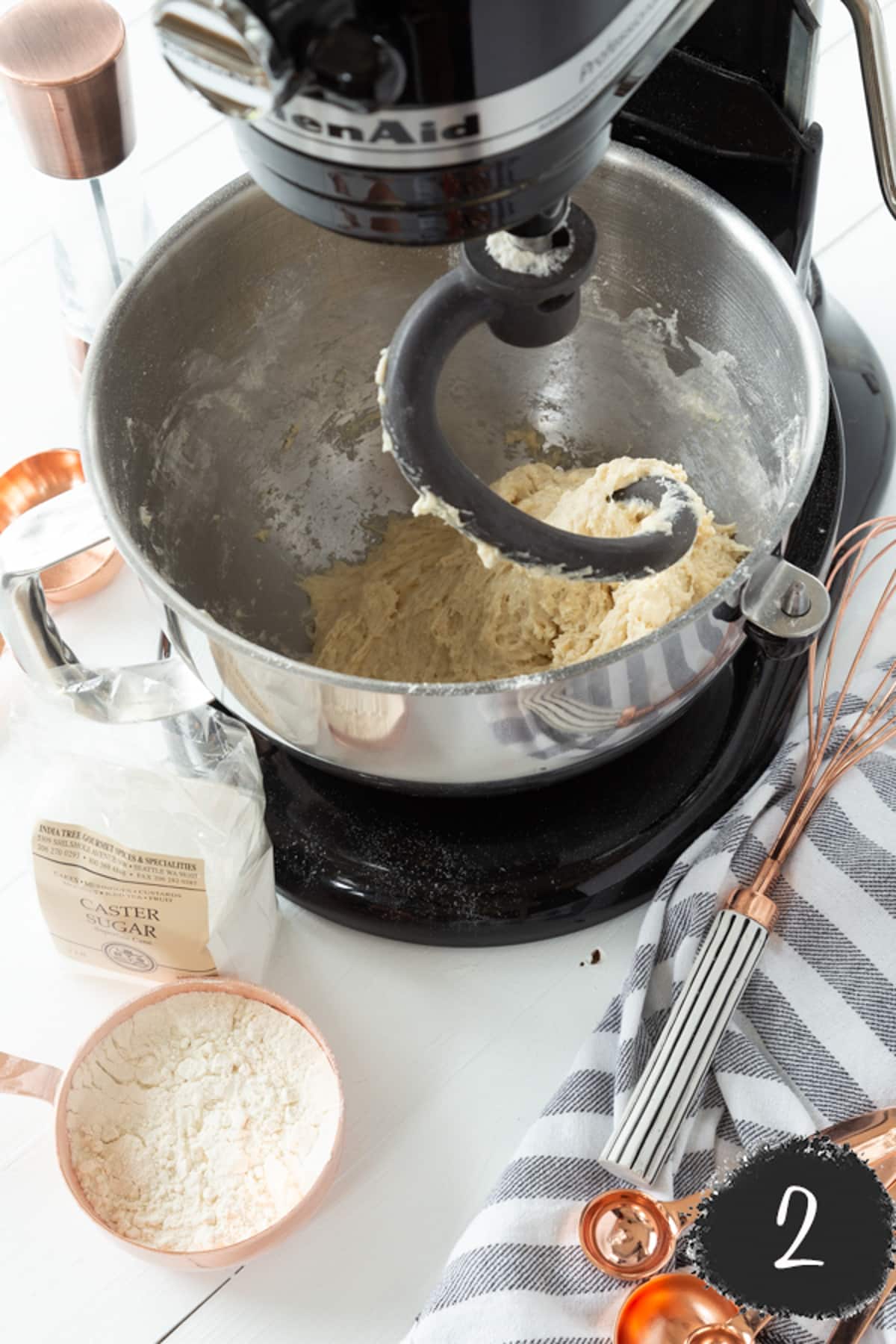
Step Two - Make the Croissant Dough
Put the proofed yeast into a stand mixer and pour the remaining milk into the mixing bowl, along with the caster sugar, and mix briefly to combine.
In a separate bowl, sift the flour to remove any lumps and in quarter cup increments slowly add the flour to the mixing bowl and mix with a dough attachment until the dough is soft and sticky.
Please Note: The amount of flour you have to use can vary. The amount of flour we usually end up using is somewhere between 2 ¼ cups and 2 ½ cups.
After the dough becomes soft and sticky, add the salt and mix to combine.
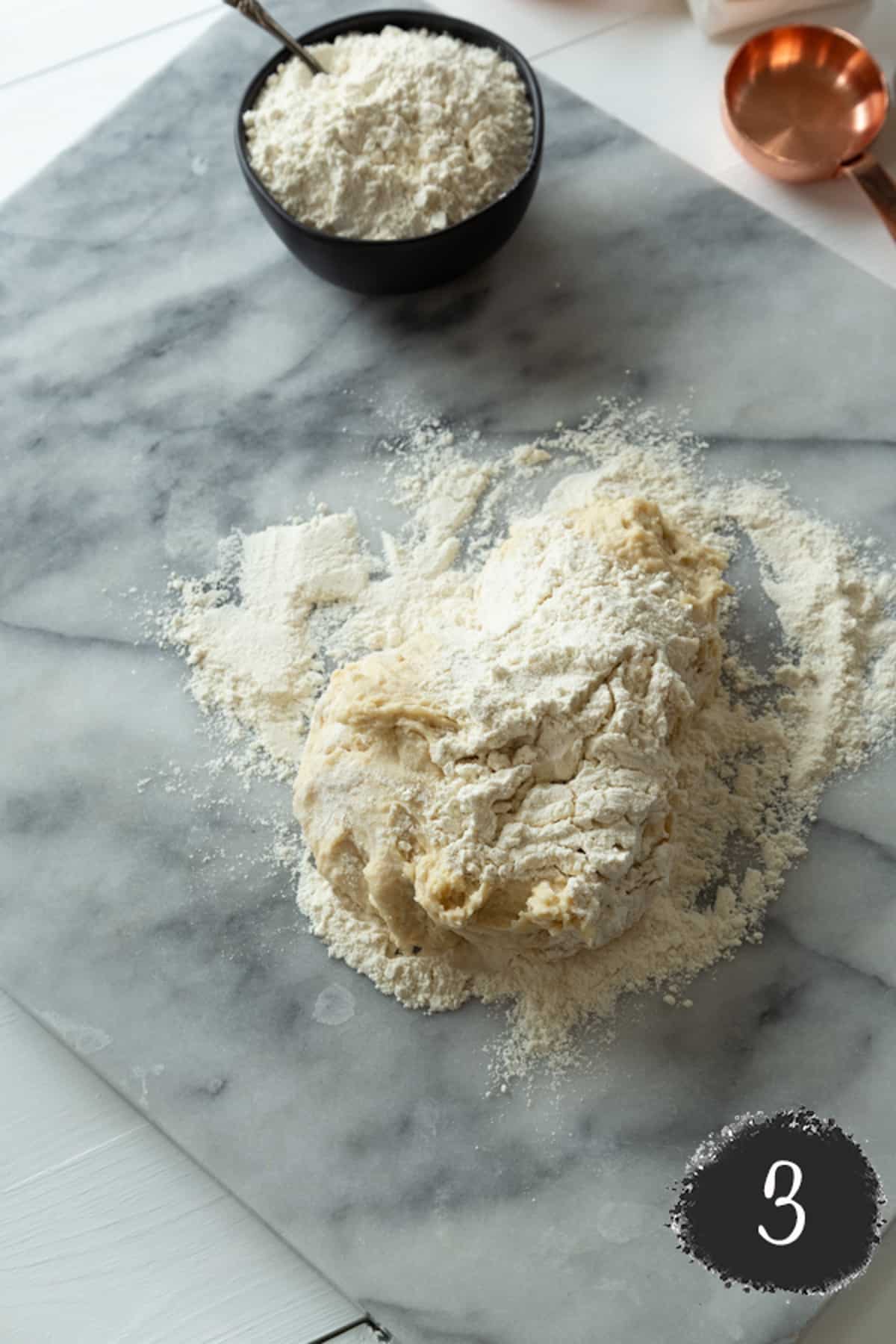
Step Three - Knead the Dough
Sprinkle a quarter of a cup of the flour onto a clean smooth work surface and prepare a plate that is dusted with about 1 tablespoon of flour.
Place the dough onto the floured surface and knead it for approximately two minutes. Sprinkle with more flour if necessary.
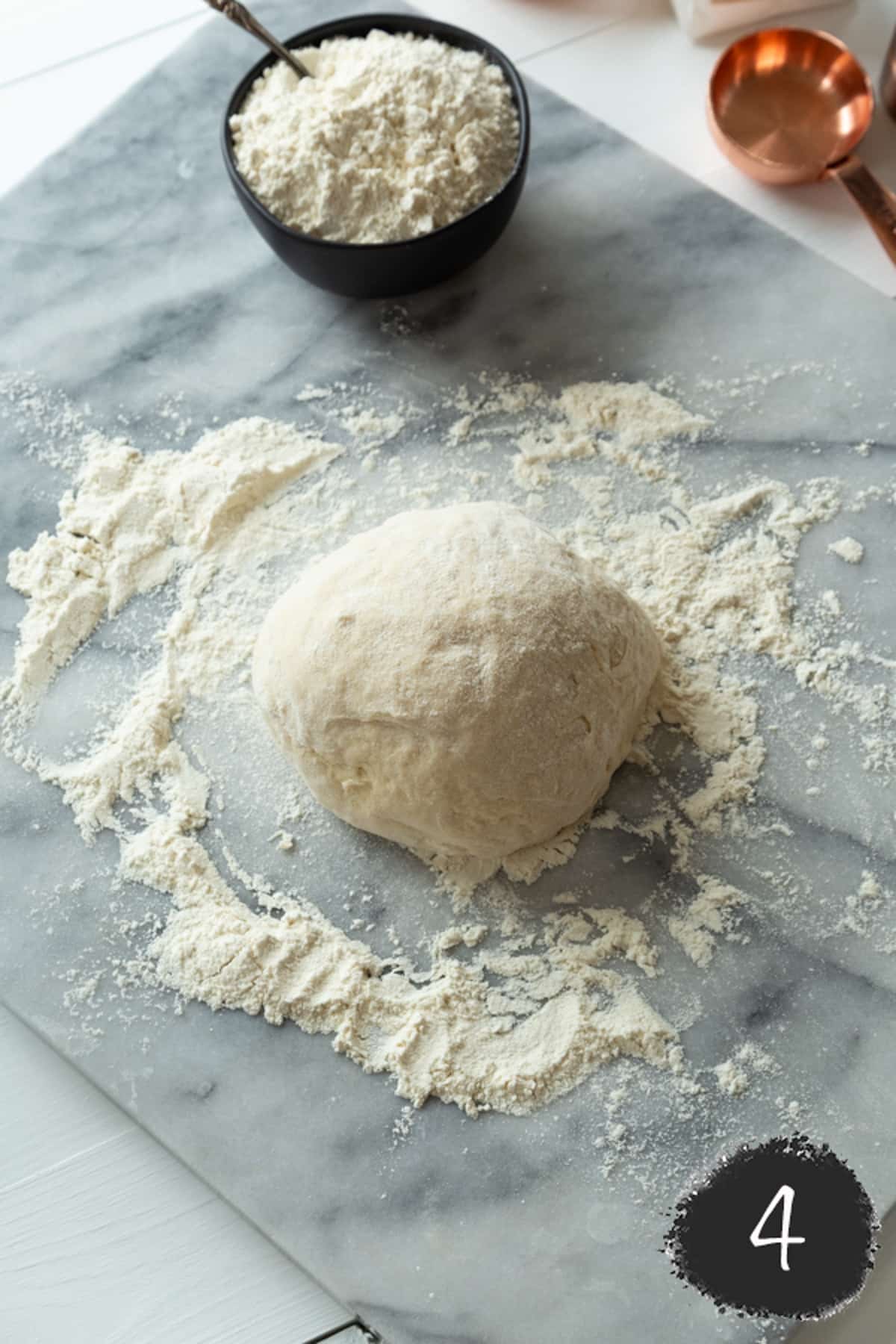
Step Four
Form the dough into a ball. If the ball starts to fall slightly the dough was made correctly.
Step Five
Place the dough on a plate and cut an X into the top of the dough and sprinkle another tablespoon of flour on top of the dough, wrap it in plastic and place it in the refrigerator.
Let the dough rest in the fridge for at least one hour.
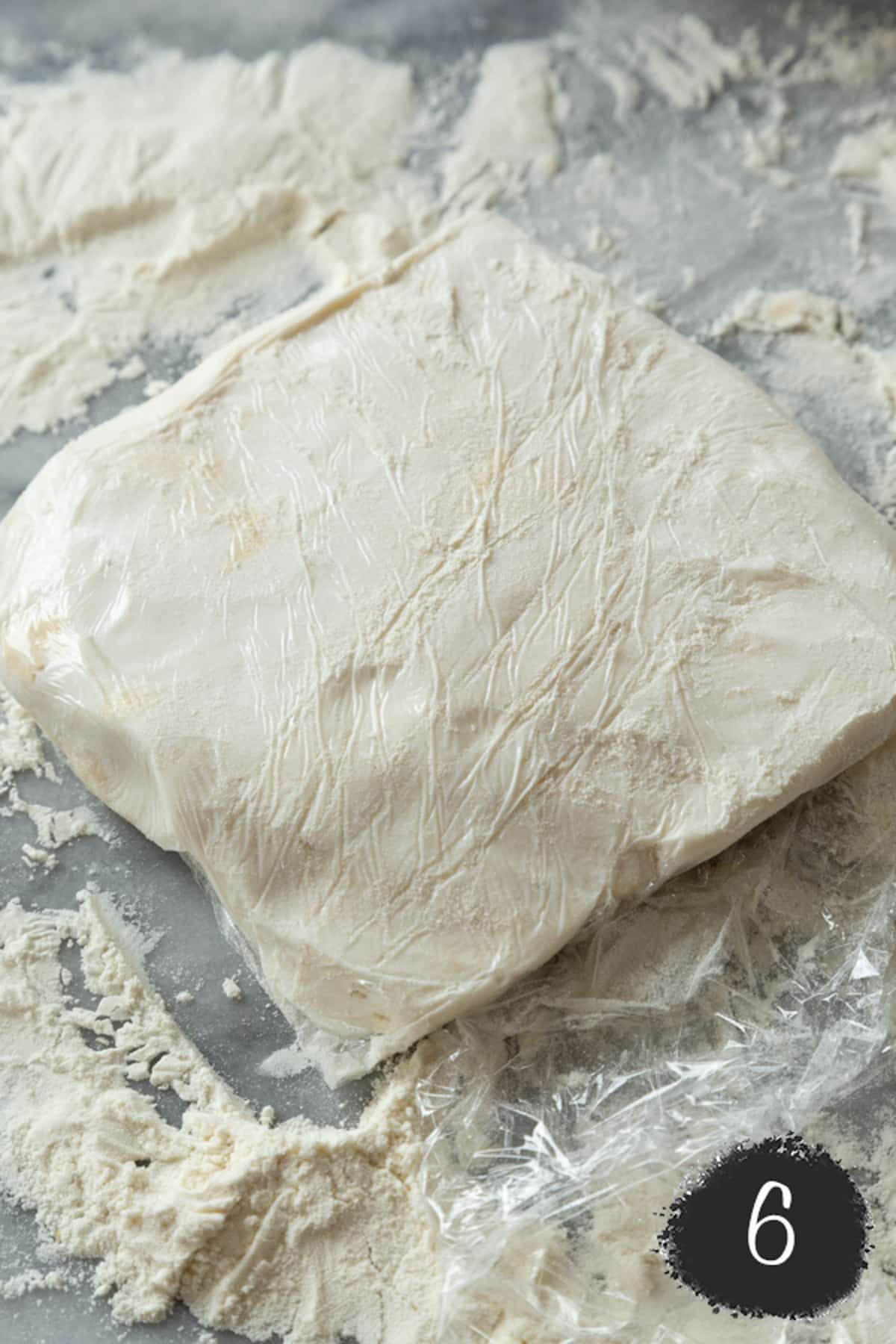
Step Six - Prepare the Butter for Lamination
Take the butter out of the refrigerator and bring it between chilled and room temperature.
In the mixer, beat the butter on medium until it is completely smooth. This should only take about a minute or two.
Add 2 tablespoons of flour to the butter and beat until it's fully combined.
Remove the butter from the mixer and place it on a floured surface and shape it into a 4 inch x 4 inch square.
Wrap the butter in plastic wrap and place it in the fridge to cool. The butter-flour block should be hard to the touch when you take it out of the fridge.
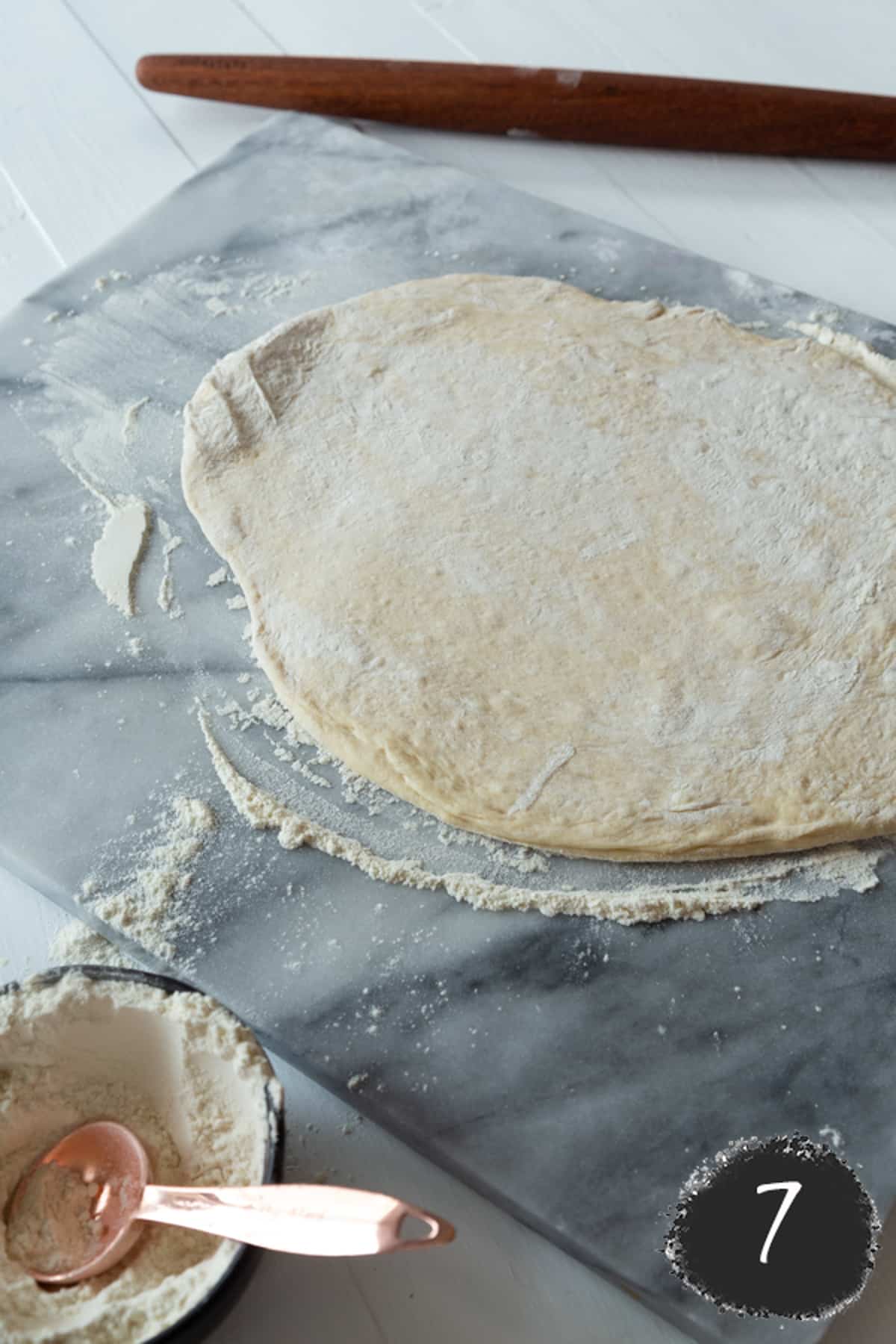
Step Seven
Once the dough has been chilled for an hour, remove it from the refrigerator and place it on a lightly floured surface.
Now, get ready to fold the dough in interesting ways.
First, roll the dough out so that the center has enough room to hold the 4x4 inch butter square.
Try to roll it into a large square, twice as large as the block of butter.
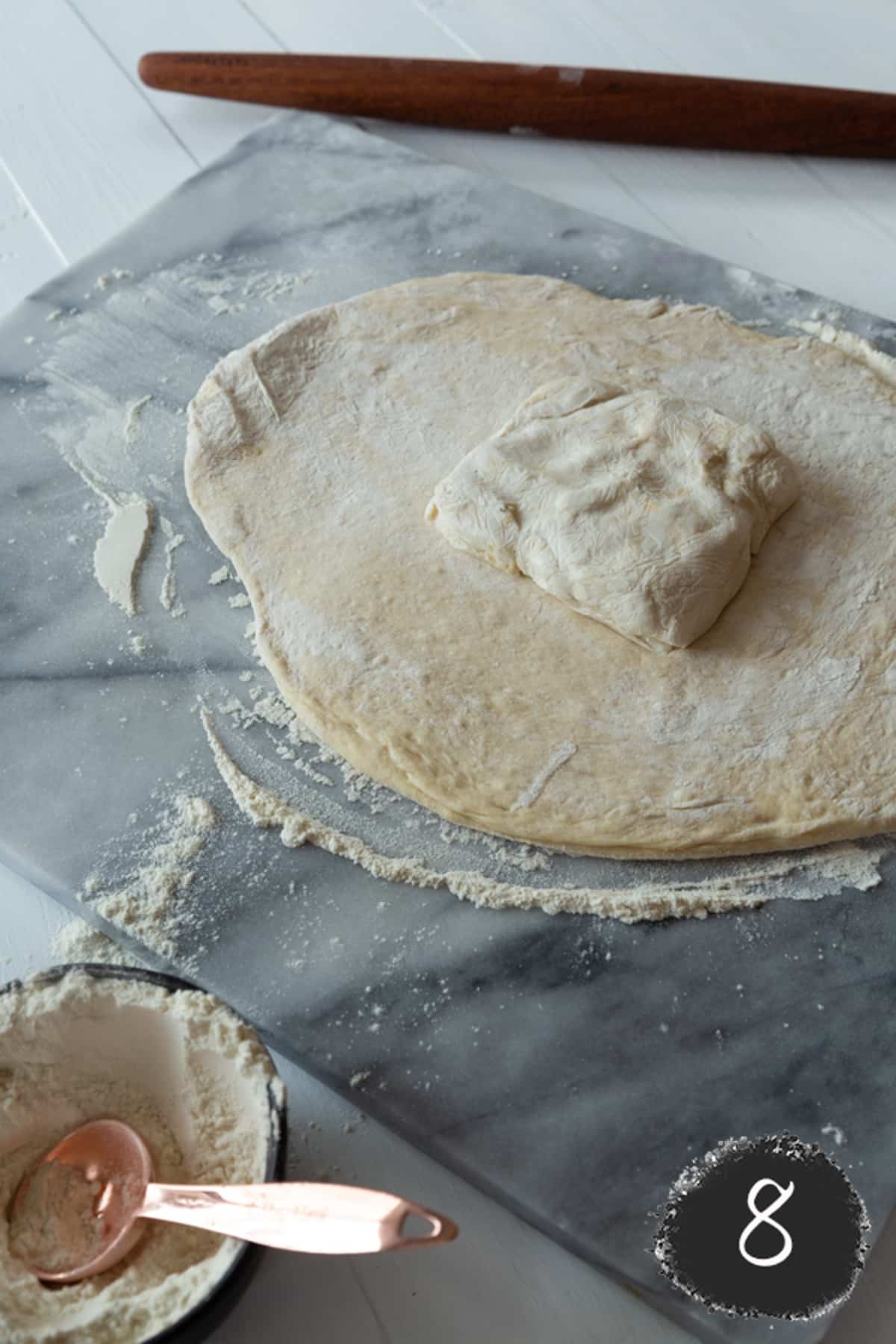
Step Eight
Place the butter block in the center of the dough.

Step Nine
Fold one side of the dough over the butter, as shown above.

Step Ten
Fold another side of the dough over the butter, as shown above.

Step 11
Fold the third side over the butter, as shown above.

Step Twelve
Fold the last side over the butter, as shown above.

Step 13
With a rolling pin, lightly pound the butter dough block approximately 8 to 10 times so the butter is evenly distributed throughout the dough.
It should look like the photo above.

Step Fourteen
Now it's time to begin folding the butter and dough several times to create layers in the croissants. This is called lamination.
Roll the dough into an 18 X 10-inch rectangle.
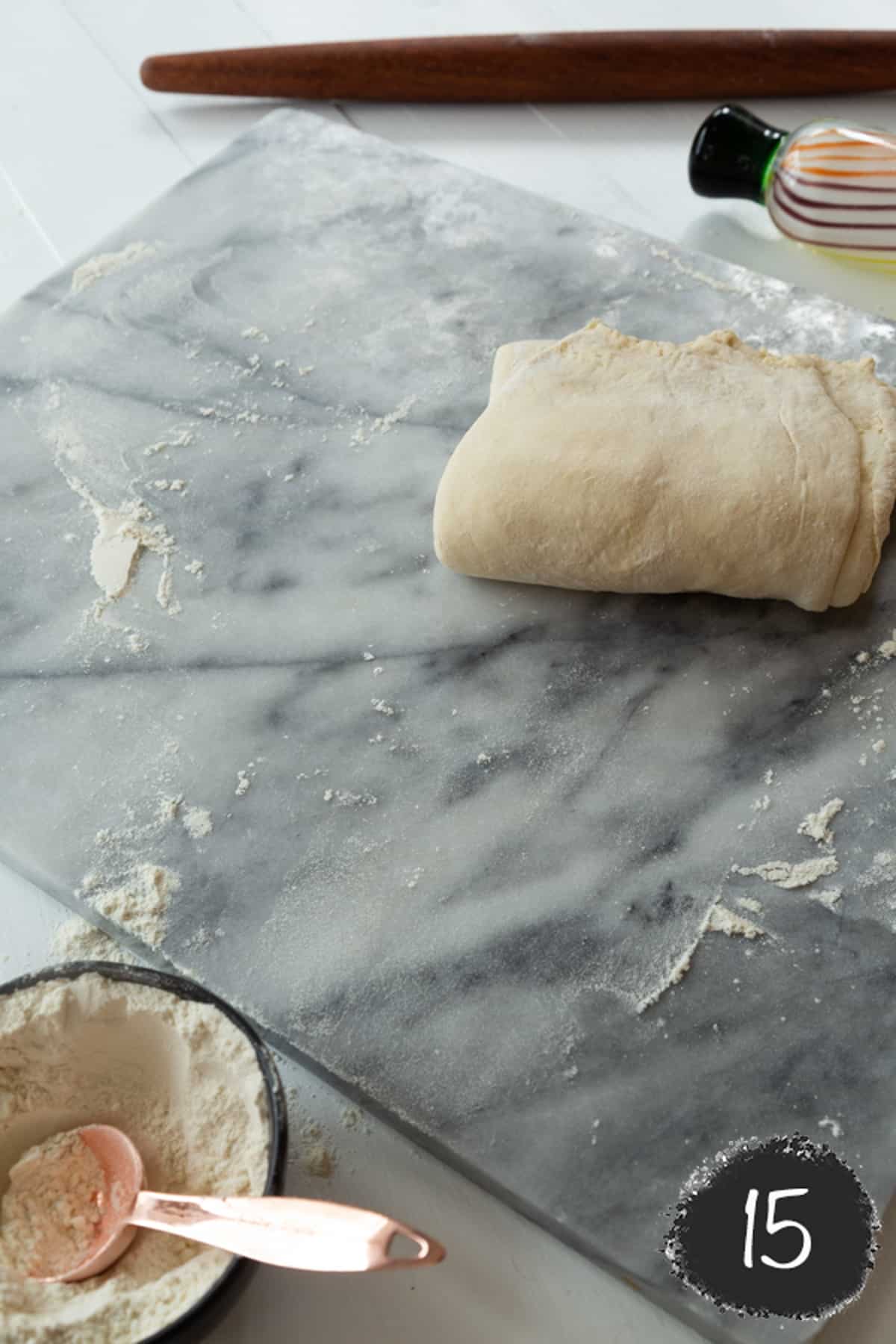
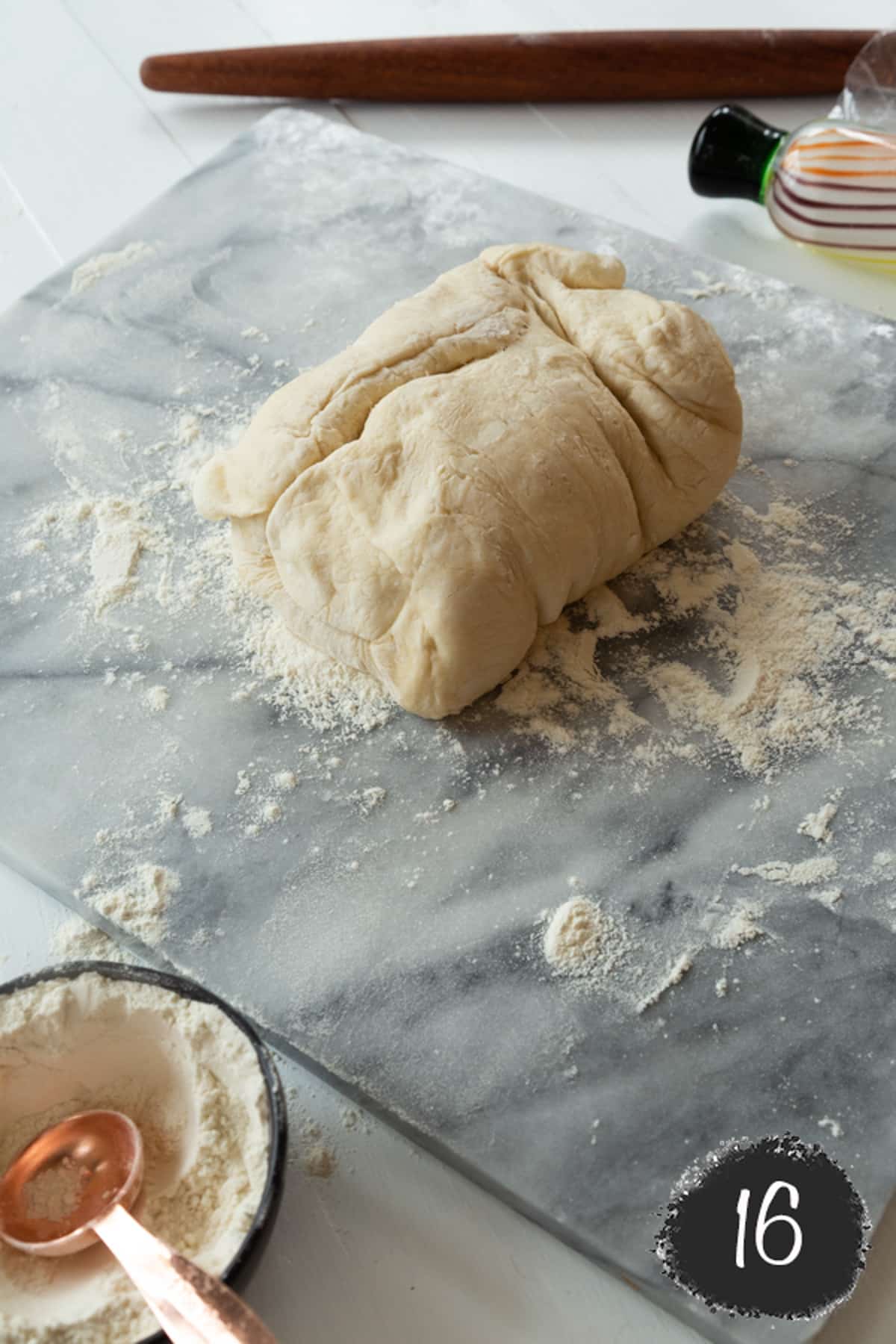
Step Fifteen and Sixteen
Now it's time to fold the rectangle into a thick square.
Imagine the rectangle as three sections. Fold the first one third section of the dough toward the middle and follow that with the second third.
Lightly roll the dough with the rolling pin so the layers stick together.
It will look like the photos above.
Wrap the dough in plastic and chill in the refrigerator for 90 minutes.
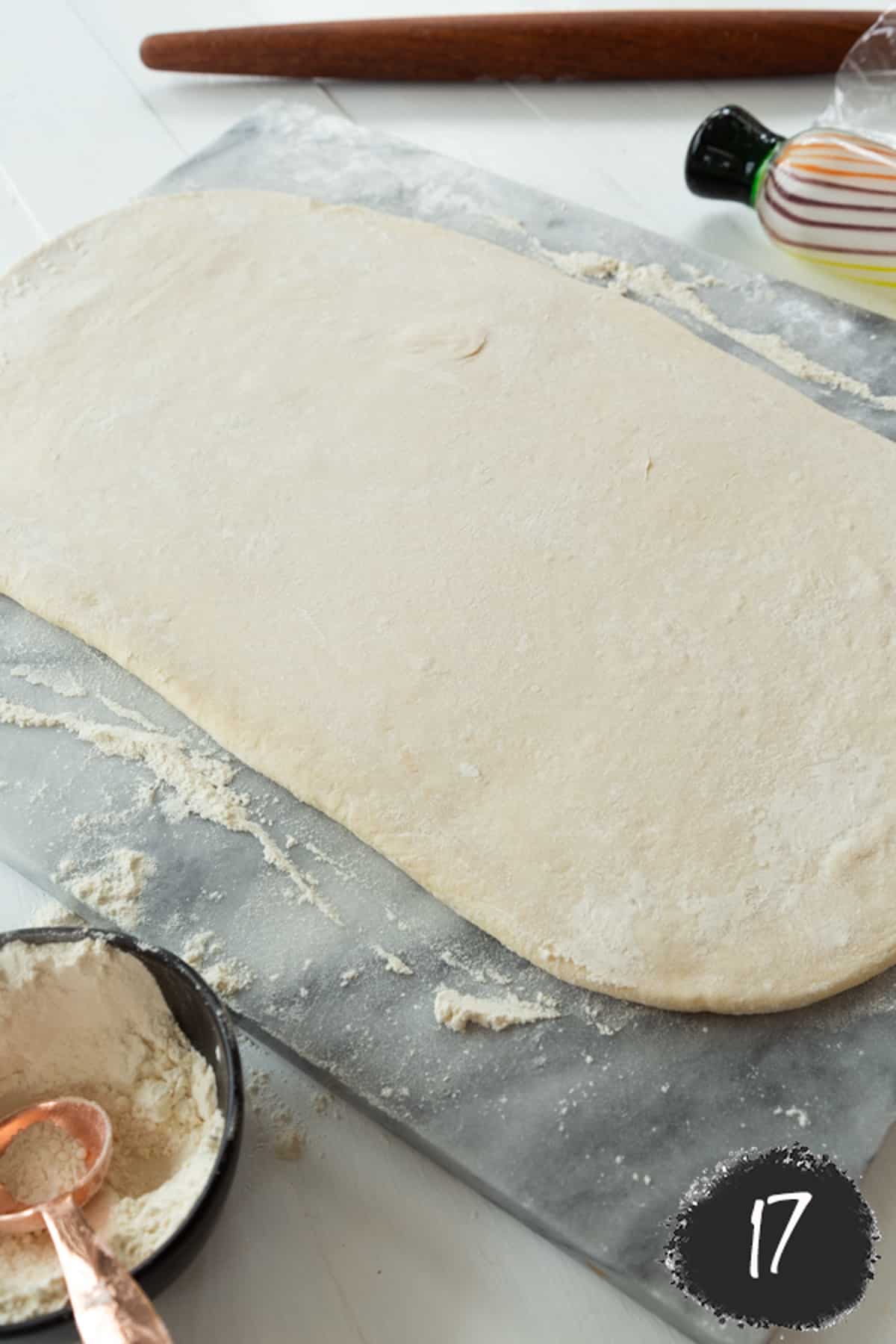
Step Seventeen
Remove the dough from the fridge and roll it back out into another long rectangle.
One more time, fold the dough into thirds like you did in steps 15 and 16 and chill the dough in the refrigerator overnight, or for a minimum of six hours.
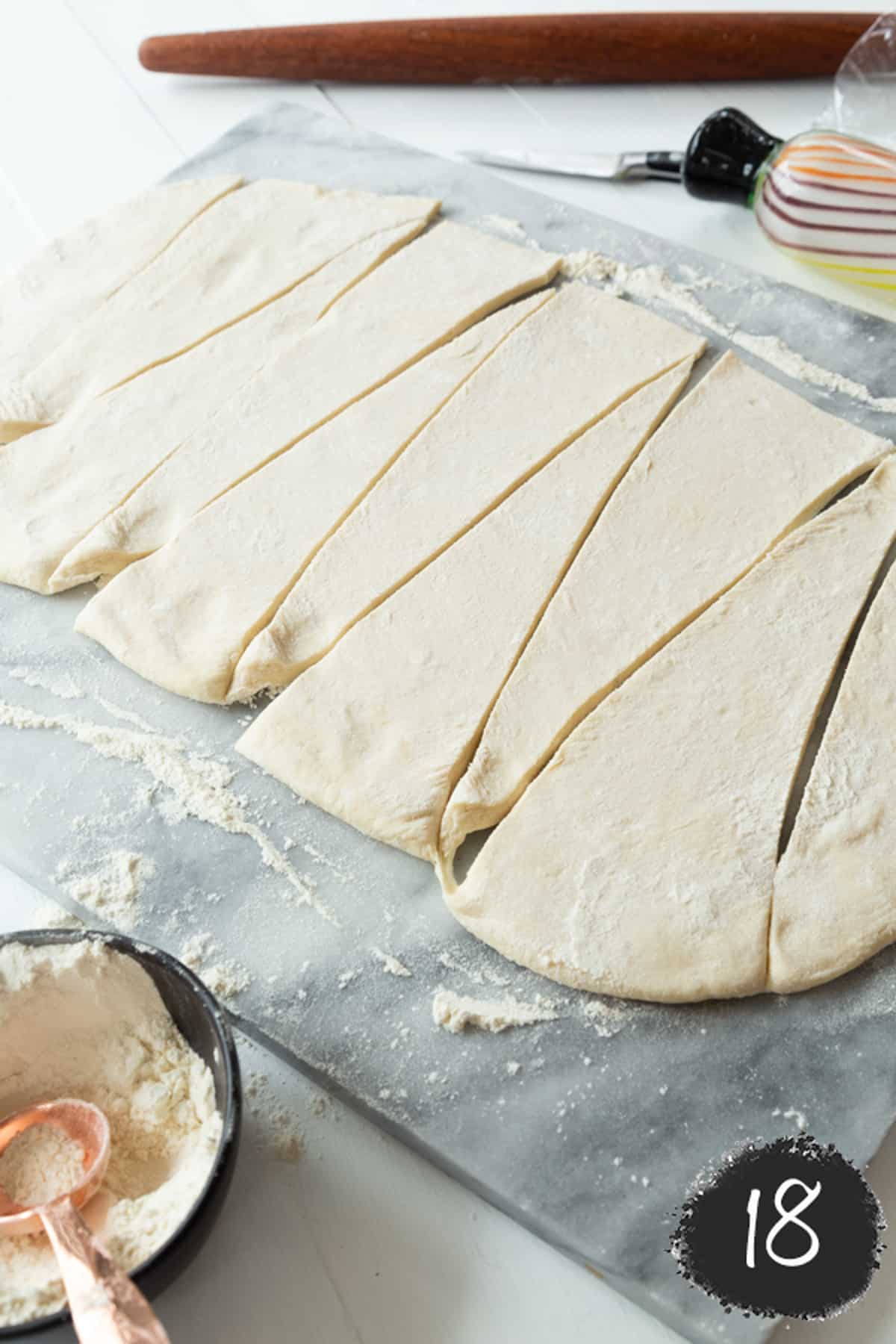
Step Eighteen
Once the dough has chilled overnight, remove it from the refrigerator and roll it out into a rectangle that is ten inches long and as wide as you can roll it out.
Cut the dough into triangles that have a base of approximately four to five inches, depending on how large you want your shaped croissants to be.
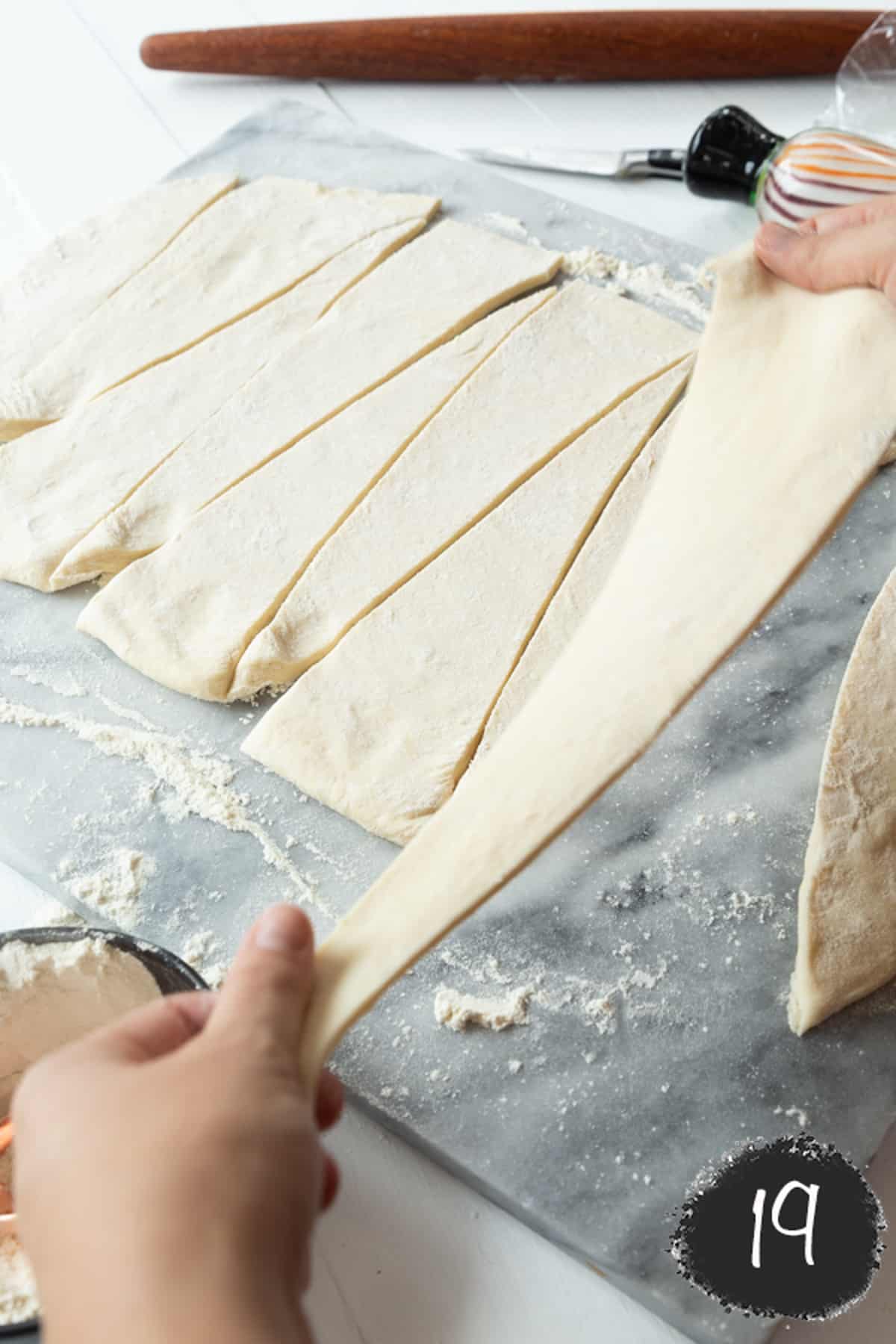
Step Nineteen
Gently stretch the triangles until they’re a couple of inches longer.

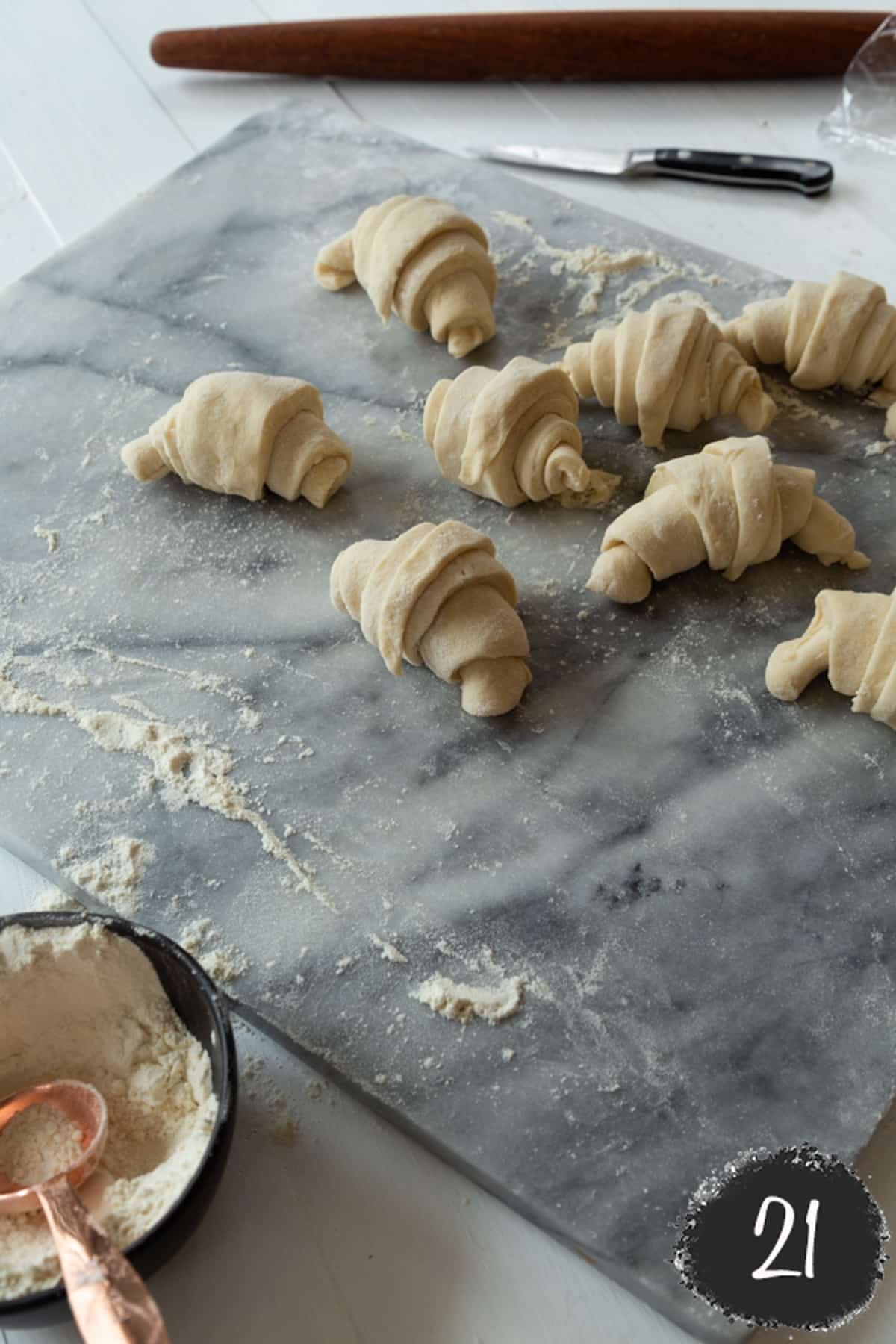
Step Twenty/Twenty One
Starting from the widest side of the triangle, roll the triangles into crescent roll shapes.
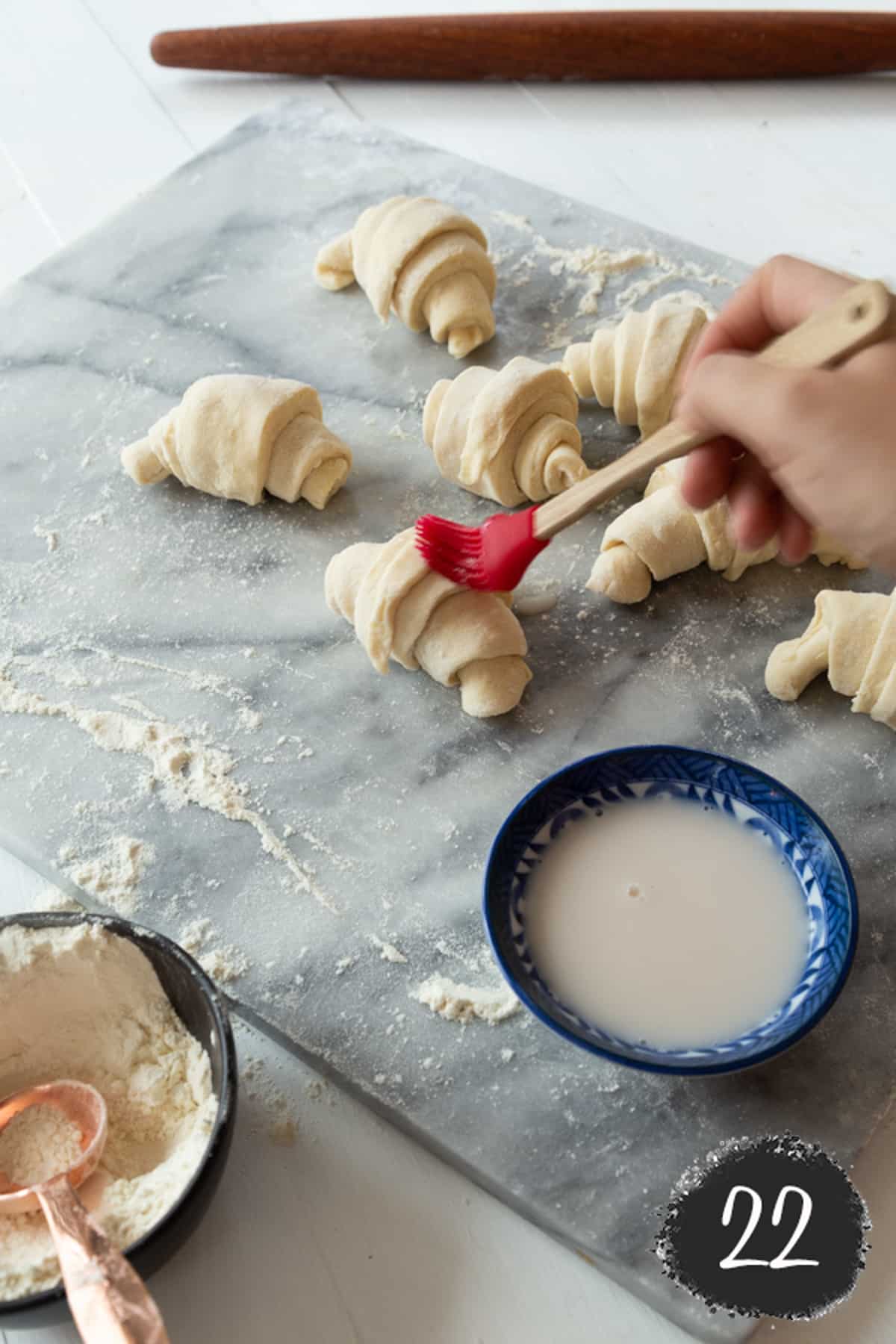
Step Twenty Two
Place the croissants in a warm location and let them rise until they double in size, this should take approximately two hours.
Transfer the croissants to a parchment paper lined baking sheet and brush them with a vegan egg wash or plant-based milk.
Bake them in a completely preheated 400°F (204°C) for ten minutes, then lower the temperature to 375°F (190°C) and bake for approximately 15 minutes or they're lightly golden brown.
Serving and Storage
Serve for breakfast with our Vegan Lemon Curd or your favorite jam and our vegan Maple Pecan Latte or a cup of tea.
They're great for making sandwiches, especially with our Easy Vegan Breakfast Sandwich recipe.
Add your favorite dried herbs and spices to the dough when you're mixing it for a savory croissant.
If you want to make a chocolate croissants, otherwise known as pain au chocolat, spread melted chocolate on the dough before rolling them up.
Store in an airtight container for up to 4 days.
Freeze in a freezer safe container for up to 2 months.
Recipe FAQs
Vegan butter is made from vegetable oil, so it's essentially margarine, which is fine to use as long as it's stable margarine. Do not use spreadable margarine as it melts too easily and won't work for this recipe.
If the butter is too cold or hard during lamination it can break the dough, conversely, if it's too warm or soft, the dough will absorb it, leading to heavy dense croissants.
More than likely they didn't rise, or proof, for enough time. They should double in size before baking so the butter doesn't leak between the layers.
No, puff pastry is heavier and similar to pie crust, where croissant dough is more like bread dough.
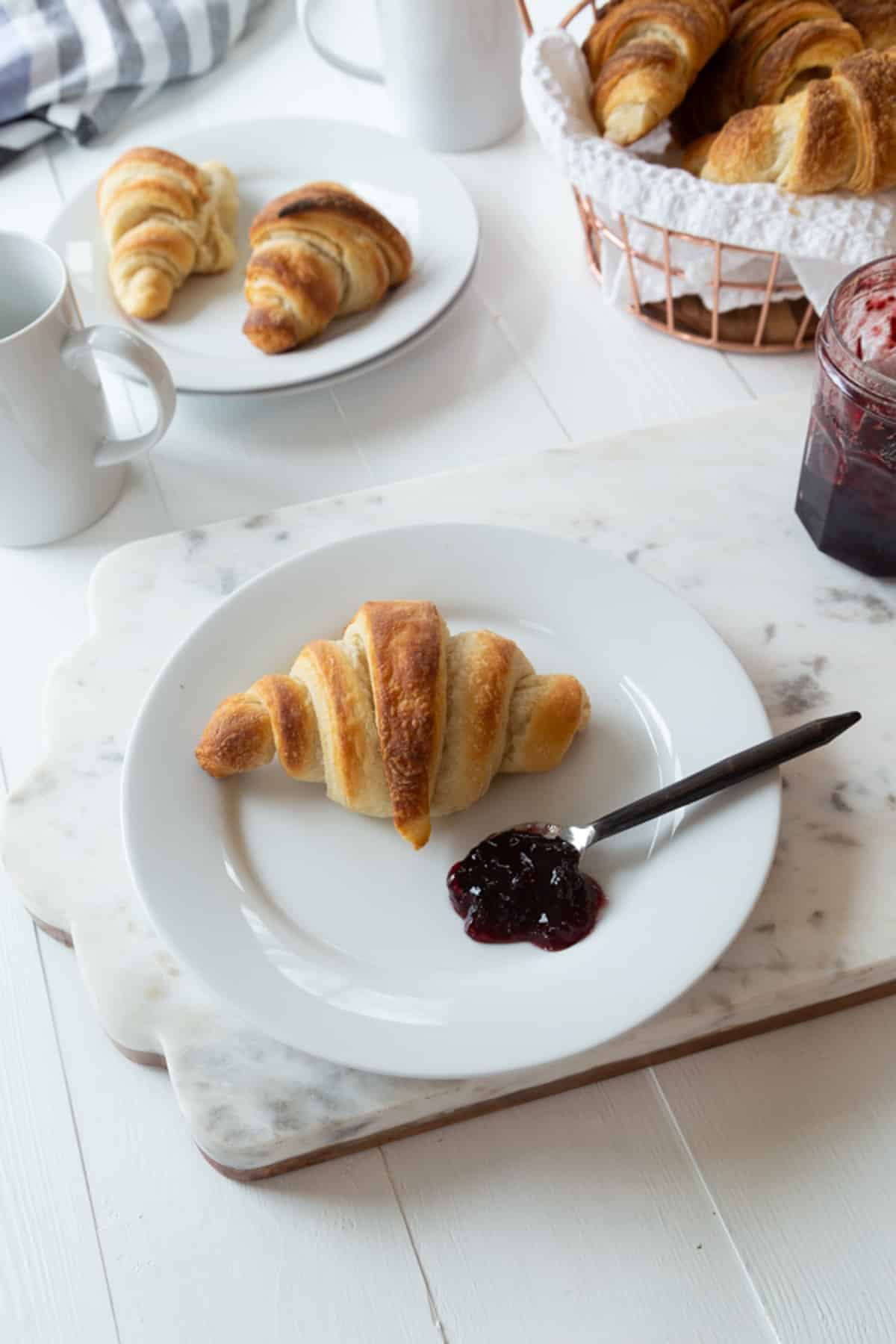
More Vegan Bread Recipes

Vegan Croissant Recipe
Equipment
- 1 mixer
- 1 Rolling Pin
- 1 Oven
Ingredients
- 2 ½ teaspoon active dry yeast
- 1 ¼ cup vanilla plant-based milk (cannot be unsweetened)
- ¼ cup caster sugar
- 3 cups pastry flour
- ½ teaspoon salt
- 1 cup vegan butter (we prefer Miyoko's)
Instructions
- Heat the milk in the microwave for twenty seconds.
- Pour one cup of the almond milk into a shallow bowl. Pour the active dry yeast on top of the almond milk and mix for a couple seconds. Now let the almond milk and yeast set for approximately five minutes, or until the yeast begins to foam. The yeast must foam in order for the croissants to turn out. If the yeast does not foam try again.
- Put the milk-yeast mixture into a stand mixer. Pour the rest of the almond milk into the mixing bowl along with the caster sugar and mix briefly to combine.
- In a separate bowl, sift the flour to remove any lumps. Slowly add the flour to the milk-yeast mixture in quarter cup increments. The dough is ready when it looks soft and sticky. The amount of flour can vary. The amount of flour we usually end up with is somewhere between 2 ¼ cups and 2 ½ cups. After the dough appears soft and sticky, add the salt and mix to combine.
- Sprinkle a quarter cup of the flour onto a clean surface and prepare a plate that is dusted with about 1 tablespoon of flour. Dump the dough onto the floured surface and kneed for approximately two minutes. Then work the dough into a ball. If the ball starts to fall slightly, the dough was made correctly.
- Place the dough on the plate and cut an X into the top of the dough. Sprinkle another tablespoon of flour on top of the dough and place it in the fridge. Let the dough rest in the fridge for at least one hour.
- While the dough is resting, take the butter and put it in your stand mixer. Beat the butter until it is completely smooth. This should only take about a minute or two. Now beat in 2 tablespoon of the flour. Mix until uniform in texture.
- Put the butter on the floured surface and shape it into a 4 inch x 4 inch square. Wrap the butter-flour mixture in plastic wrap and place it in the fridge to cool. The butter-flour block should be hard to the touch when you take it out of the fridge.
- Once the dough has been in the fridge for an hour, remove it and put it back on the floured surface. Now, get ready to roll out this dough is some semi-complicated ways.
- You’re going to roll out your dough so that the center has enough room to hold that 4x4 butter square. Roll your dough into a large square, much larger than the butter block.
- Place the butter block in the center of the dough like shown below and fold in each of the petals. It should look like a nice little present.
- Here’s the fun part, take your rolling pin and lightly smack the butter-dough wrap. We hit it about eight times to make sure the butter is evenly distributed throughout the dough. Now roll the dough into an 18 by 10 rectangle.
- Now we’re going to make our next fold. Imagine the dough in three sections. You’re going to make the fold so that the end result looks like a thick square, not a long rectangle. Fold the first third of the dough over, following by the second third. Lightly roll the dough to make sure the layers stick together.
- Pop the dough back in the fridge for an hour and a half.
- Remove the dough from the fridge and roll it back out into another long rectangle. Do another tri-fold and set that dough back into the fridge for a minimum of six hours.
- When the six hours are up, take the dough out of the fridge and roll it out into a rectangle that is ten inches long and as wide as you can roll it out. Cut the dough into triangles that have a base of approximately four to five inches, depending on how large you want your croissants. Take the triangles and slightly stretch them out, just so they’re a couple inches longer. Starting from the widest side of the triangle, roll the triangles into crescent shapes.
- Transfer the croissants to a parchment lined baking sheet and brush each of them with the rest of the almond milk. Let the dough sit out until the croissants double in size, this should take approximately two hours.
- Preheat the oven to 400°F (204°C). Bake the croissants for ten minutes at this temperature. Then drop the oven temperature to 375°F (190°C) and bake for fifteen minutes or until golden brown on top.
- See the step by step instruction photos above.
Video
Notes
- Vegan Butter - We recommend using Miyoko's Cultured Vegan Butter or Earth Balance sticks. Miyoko's has an authentic buttery flavor, but it's more expensive than Earth Balance. Don't use spreadable butter in a tub as it contains more water, which could prevent the croissants from developing flaky layers.
- Flour - Bread flour is best for making croissants because it has more gluten, and that will help the croissants develop the best texture. You can use all-purpose flour if you must, but bread flour is best.
- Sugar - We recommend using caster sugar because it's ground into a fine, almost powdery texture. This will help the croissants stay light and airy. You can put granulated sugar in a blender or food processor to make caster sugar.
- Yeast - Use active dry yeast for best results.
Recipe FAQs
Nutrition
This post may contain affiliate links which won’t change your price but will share some commission.



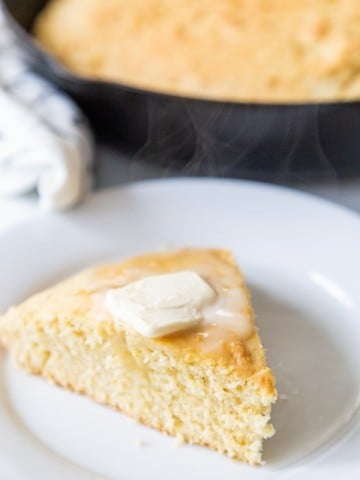

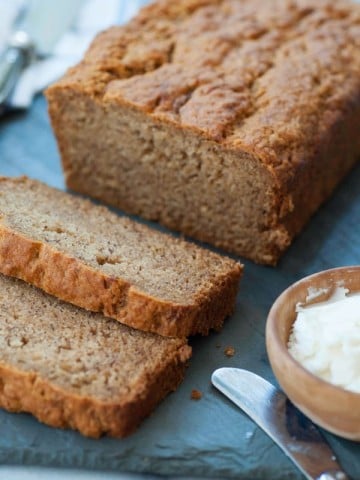


Tom says
Hi there,
I was just wondering after the dough is done, you said leave it in a fridge for minimum of 6 hours.
Is there any maximum hours ?
Let's say I wanna have it ready in a morning, and finish the dough in the evening/ afternoon, can I keep it in a fridge even for like 12,-14 hours ??
Thank you !
Linda Meyer says
Hey Tom! Thanks for the question! Just make sure the dough is properly covered so it doesn't crust over and you should be good to keep it in the fridge for 12-14 hours! I just wouldn't use it past 24 hours in the fridge.
Alex
Tom says
Hi again,
I was trying to today, and everything went pretty much how you described it, during the 2 hours it has risen nicely, but then I put it in the oven and it just went quite flat again, do you know what could cause it ?
Thank you !
Tom
Linda Meyer says
Hey Tom, So bummed to hear they went flat! There are a couple of things that could've possibly happened. Because croissants are so delicate its very important to use very specific ingredients to achieve the results so that's where I'd start first; make sure you're using pastry flour (not all purpose), active dry yeast (not instant yeast), and caster sugar (not granulated sugar). Secondly, make sure you're not over-adding yeast. I know it sounds strange but accidentally over-pouring yeast can cause the dough to fall once in the oven. Last, when you make the recipe again you could try adding 1/4 more of a teaspoon of salt to the recipe to help the dough stay risen in the oven. Hope this helps and let me know if you have any more questions!
Gemma-Lynn Evangelista says
Is the dough suppose to be too sticky to mold?
I've tried to remake the dough twice and both times it's been too sticky to roll out?
Linda Meyer says
Hey Gemma-Lynn,
Thank you for your comment! No, the dough is not supposed to be sticky. May I ask what kind of flour you're using? Many factors could be contributing to the dough being sticky, but the one suggestion I have is that you could add flour in tbsp increments until the texture of your dough matches the pictures.
Alex
Leah says
Hello Alex and Linda, what is the purpose of letting the dough rest in the fridge for a minimum of 6 hours? Thank you.
Alex Meyer, MA says
Hey Leah,
You want to give the butter enough time to return to a completely solid, and chilled form, so when you let the croissants rise and then eventually bake, the butter hasn't completely melted. If the butter melts before baking it doesn't create those air pockets that croissants are famous for : )
Hope that helps!
Alex & Linda
prema says
Hello,
Exactly why is it pertinent that the milk be unsweetened?
prema says
*sweetened
Alex Meyer, MA says
Hey Prema,
When making croissants I like to be able to control the level of sweetness myself by using unsweetened plant milks. However, you can absolutely use sweetened milks, but the sweetness of the croissants might be different than it would be if the recipe was followed with unsweetened. I don't think this would be a bad thing if you enjoy a little extra sugar though : ) Hope that helps!
Have an awesome day,
Alex & Linda
Ginny Smith says
I was wondering, once the croissants are formed should they be covered while they rise?
Alex Meyer, MA says
Hey Ginny,
Yeah, you can absolutely cover the croissants while they rise! Have an awesome day!
- Alex
Joe Mazza says
I was just wondering if I can freeze the croissants at any point during the recipe. Should I proof them first and then freeze? Or freeze before they proof? I want the croissants to be fresh but I don’t have any space in the kitchen to cook on thanksgiving day.
Alex Meyer, MA says
Hey Joe! Thanks for the comment! I wouldn't recommend freezing the croissants before baking them because the thawing out process could affect the texture of the croissants. What I would do, is make them the day before and just keep them in the fridge, covered, until you're ready to bake them Thanksgiving day : ) Hope this helps!
- Alex
Joe Mazza says
Good idea. I’ll try!
Yuri says
When resting the dough...does it have to wrapped in plastic??
Linda Meyer says
Hi Yuri, you could wrap the dough in a clean towel (make sure it wasn't washed or dried with scented products); however, the butter should be wrapped in plastic or parchment to prevent lint from sticking to it.
Linda Meyer says
I forgot to mention, the towel should be slightly damp. The reason for this is so the dough doesn't develop a crust.
Yuri says
When resting the dough the first time...it goes in the fridge uncovered?
Linda Meyer says
Yes. 🙂
Alon says
Hey, this looks great!
A couple of questions - it's possible to add more folds right? Just wait an hour and half or so between them?
As for the "wash", do you know of a way to replicate the shine of non vegan croissants? I thought they used simple syrup or something, and that sounds vegan to me. What do you think?
Alex Meyer, MA says
Hey! You can definitely put in more folds if you want. You're totally right, just let it rest in the fridge in between. For a wash you can definitely use a simple syrup or a vegan egg wash with a dash of sugar. Hope this helps!
Erin says
What method do you use to measure flour?
Alex Meyer, MA says
Hey Erin, Thanks so much for the question! We prefer to weigh our flours and sugars when baking, but we know this isn't easy for everyone so we try to get our measuring cup instructions as close as possible to the weighted measurements. Hope this helps!
Jonatnan Molea says
Great Article, I have a suggestion if you go to Miami please visit L'Artisane Creative Bakery (@lartisanebakery) in instagram, they are the next level in vegan croissants and I think is good to share this information.
Linda Meyer says
Thank you, Jonatnan! We will definitely put this on our list. 🙂
Rahul says
Great Recipe. Looks Easy and Delicious
Linda Meyer says
Thank you, Rahul!
Christine @ Run Plant Based says
Yum, these look wonderful and I'm tempted to try them and go to Paris. Thanks!
Linda Meyer says
Thank you! Wouldn't that be wonderful?